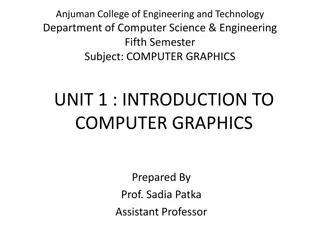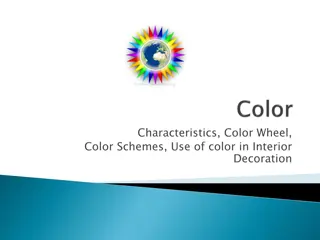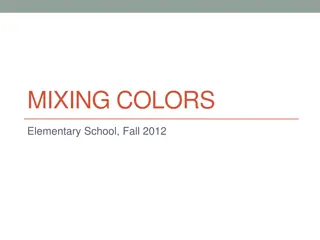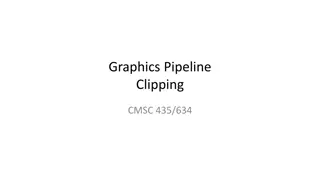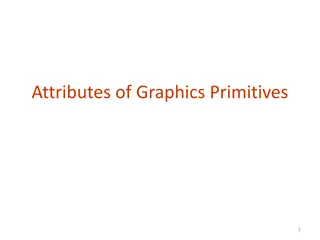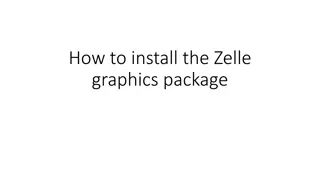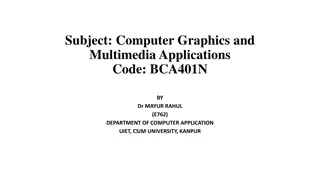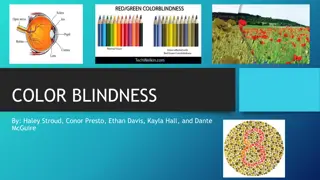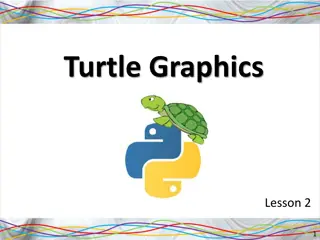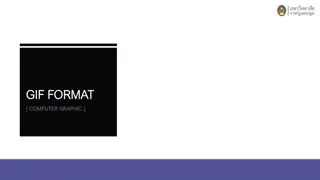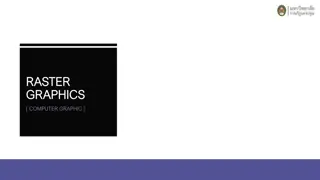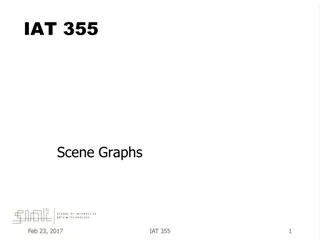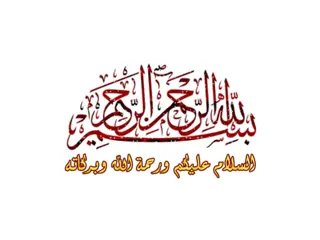Overview of Color Models in Computer Graphics
Color models in computer graphics play a crucial role in creating a wide range of colors using a limited set of primary colors. There are two main types of color models - additive and subtractive, with RGB being common for displays and CMYK for printing. RGB is additive, combining red, green, and blue light to produce colors, while CMYK is subtractive, using cyan, magenta, yellow, and black inks for printing. Understanding these models is essential for color reproduction in digital and print media.
Download Presentation

Please find below an Image/Link to download the presentation.
The content on the website is provided AS IS for your information and personal use only. It may not be sold, licensed, or shared on other websites without obtaining consent from the author. Download presentation by click this link. If you encounter any issues during the download, it is possible that the publisher has removed the file from their server.
E N D
Presentation Transcript
COLOR MODELS OF COMPUTER GRAPHICS Prof. Bailappa Bhovi Department of Computer Engineering International Institute of Information Technology, I IT www.isquareit.edu.in
Color Model A color model is an orderly system for creating a whole range of colors from a small set of primary colors. There are two types of color models, those that are subtractive and those that are additive. Additive color models use light to display color while subtractive models use printing inks. Colors perceived in additive models are the result of transmitted light. Colors perceived in subtractive models are the result of reflected light. International Institute of Information Technology, I IT, P-14, Rajiv Gandhi Infotech Park, Hinjawadi Phase 1, Pune - 411 057 Phone - +91 20 22933441/2/3 | Website - www.isquareit.edu.in | Email - info@isquareit.edu.in
Color Model There are several established color models used in computer graphics, but the two most common are the RGB model (Red-Green-Blue) for computer display and the CMYK model (Cyan-Magenta-Yellow-Black) for printing. International Institute of Information Technology, I IT, P-14, Rajiv Gandhi Infotech Park, Hinjawadi Phase 1, Pune - 411 057 Phone - +91 20 22933441/2/3 | Website - www.isquareit.edu.in | Email - info@isquareit.edu.in
RGB Color Model RGB is an additive color model For computer displays uses light to display color , Colors result from transmitted light Red + Green + Blue = White International Institute of Information Technology, I IT, P-14, Rajiv Gandhi Infotech Park, Hinjawadi Phase 1, Pune - 411 057 Phone - +91 20 22933441/2/3 | Website - www.isquareit.edu.in | Email - info@isquareit.edu.in
CMYK Color Model CMYK (subtractive color model) is the standard color model used in offset printing for full-color documents. Because such printing uses inks of these four basic colors,it is often called four-color printing. Where two colors of RGB overlaps, we see a new color formed by mixing of the two additive primaries. These new colors are: A greenish blue called cyan. A blushed red called magenta. A bright yellow. The key color , Black. International Institute of Information Technology, I IT, P-14, Rajiv Gandhi Infotech Park, Hinjawadi Phase 1, Pune - 411 057 Phone - +91 20 22933441/2/3 | Website - www.isquareit.edu.in | Email - info@isquareit.edu.in
CMYK Color Model We can express this effect pseudo-algebraically. Writing R, G and B for red, green and blue, C, M and Y for cyan, magenta and yellow, and W for white, and using (+) to mean additive mixing of light, and ( ) to mean subtraction of light, we have: C (cyan) = G + B = W - R M (magenta) = R + B = W - G Y (yellow) = R + G = W B In each equation, the colour on the left is called the complementary colour of the one at the extreme right; for example, magenta is the complementary colour of green. International Institute of Information Technology, I IT, P-14, Rajiv Gandhi Infotech Park, Hinjawadi Phase 1, Pune - 411 057 Phone - +91 20 22933441/2/3 | Website - www.isquareit.edu.in | Email - info@isquareit.edu.in
The process of reflection when we talk of 'cyan ink', we mean ink that, when it is applied to white paper and illuminated by white light will absorb the red component, allowing the green and blue, which combine to produce the cyan colour, to be reflected back. International Institute of Information Technology, I IT, P-14, Rajiv Gandhi Infotech Park, Hinjawadi Phase 1, Pune - 411 057 Phone - +91 20 22933441/2/3 | Website - www.isquareit.edu.in | Email - info@isquareit.edu.in
If we apply a layer of such an ink to white paper, and then add a layer of yellow, the yellow ink will absorb incident blue light, so the combination of the produces a green colour. cyan and yellow inks International Institute of Information Technology, I IT, P-14, Rajiv Gandhi Infotech Park, Hinjawadi Phase 1, Pune - 411 057 Phone - +91 20 22933441/2/3 | Website - www.isquareit.edu.in | Email - info@isquareit.edu.in
Similarly, combining cyan and magenta inks produces blue. A combination of all three colours will absorb all incident light, producingblack. International Institute of Information Technology, I IT, P-14, Rajiv Gandhi Infotech Park, Hinjawadi Phase 1, Pune - 411 057 Phone - +91 20 22933441/2/3 | Website - www.isquareit.edu.in | Email - info@isquareit.edu.in
These subtractive primaries are the primary colours which the artist working in conventional media must use. Besides, the range of colours that can be produced by mixing of primary coloured paint. International Institute of Information Technology, I IT, P-14, Rajiv Gandhi Infotech Park, Hinjawadi Phase 1, Pune - 411 057 Phone - +91 20 22933441/2/3 | Website - www.isquareit.edu.in | Email - info@isquareit.edu.in
Combining actual inks of all three colours does not produce a very good black. On top of this, applying three different inks is not very good for your paper and leads to longer drying times. For these reasons, in magazine and book printing, the three subtractive primaries are augmented with black. International Institute of Information Technology, I IT, P-14, Rajiv Gandhi Infotech Park, Hinjawadi Phase 1, Pune - 411 057 Phone - +91 20 22933441/2/3 | Website - www.isquareit.edu.in | Email - info@isquareit.edu.in
HSV Color Model Hue, Saturation, Value or HSV is a color model that describes colors (hue or tint) in terms of their shade (saturation) and their brightness (value). HSV color model is based on polar coordinates; Developed in the 1970s for computer graphics applications, HSV is used today in color pickers, in image editing software, and less commonly in image analysis and computer vision. International Institute of Information Technology, I IT, P-14, Rajiv Gandhi Infotech Park, Hinjawadi Phase 1, Pune - 411 057 Phone - +91 20 22933441/2/3 | Website - www.isquareit.edu.in | Email - info@isquareit.edu.in
HSV Color Model Hue (H), the color type (such as red, green). It ranges from 0 to 360 degree, with red at 0 degree, green at 120 degree, blue at 240 degree and so on. The two representations rearrange the geometry of RGB in an attempt to be more intuitive and perceptually relevant ,based on the color wheel. International Institute of Information Technology, I IT, P-14, Rajiv Gandhi Infotech Park, Hinjawadi Phase 1, Pune - 411 057 Phone - +91 20 22933441/2/3 | Website - www.isquareit.edu.in | Email - info@isquareit.edu.in
HSV Color Model Saturation (S) of the color ranges from 0 to 100%. Also sometimes, it called the "purity". The lower the saturation of a color, the more "grayness" is present and the more faded the color will appear. Value (V), the Brightness (V) of the color ranges from 0 to 100%. It is a nonlinear transformation of the RGB color space. Note that HSV and HSB are the same. International Institute of Information Technology, I IT, P-14, Rajiv Gandhi Infotech Park, Hinjawadi Phase 1, Pune - 411 057 Phone - +91 20 22933441/2/3 | Website - www.isquareit.edu.in | Email - info@isquareit.edu.in
HSV colour picker HSV colour picker is used to control the V value, while the corresponding slices through the cylinder are displayed, and a colour is selected by clicking on a point in the disk. The RGB picker below simply uses sliders to control the three components, while the spectrum picker at the bottom lets you pick your colour directly by clicking. International Institute of Information Technology, I IT, P-14, Rajiv Gandhi Infotech Park, Hinjawadi Phase 1, Pune - 411 057 Phone - +91 20 22933441/2/3 | Website - www.isquareit.edu.in | Email - info@isquareit.edu.in
International Institute of Information Technology, IIT, P-14, Rajiv Gandhi Infotech Park, Hinjawadi Phase 1, Pune - 411 057 Phone - +91 20 22933441/2/3 | Website - www.isquareit.edu.in | Email - info@isquareit.edu.in







